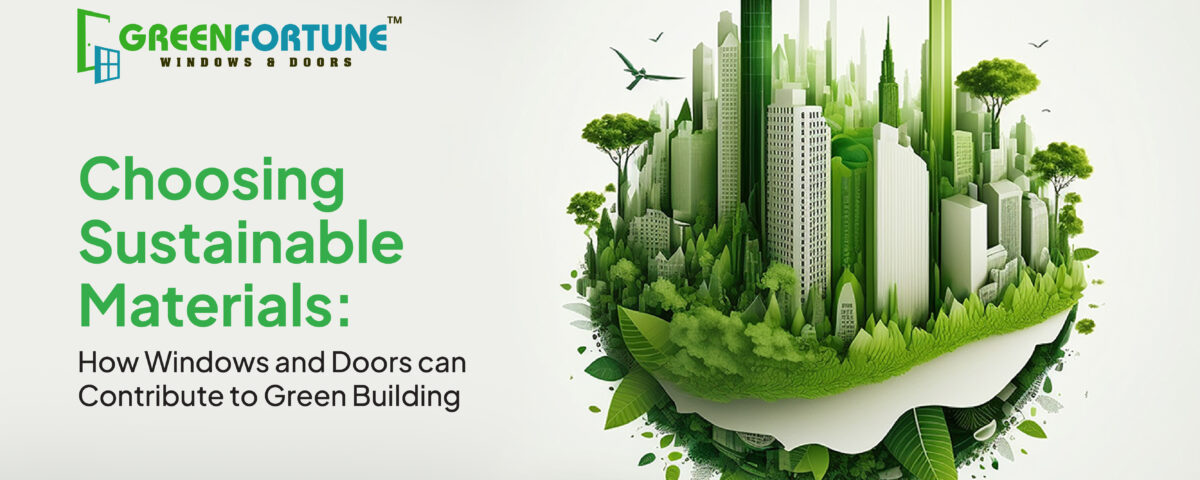
Why GreenFortune Stands Out Among uPVC Windows Manufacturers in India
September 28, 2023Buildings are responsible for approximately 39% of global carbon emissions, 28% from operational emissions, and 11% from materials and construction .These staggering statistics underscore the urgent need for a fundamental shift in the way we conceive, design, and construct our built environments.
At the heart of this transformation lie sustainable materials, and within this realm, windows and doors play a pivotal role. In a world that is increasingly conscious of environmental sustainability, the choices we make in constructing our buildings have far-reaching consequences. As a significant player in the building materials industry, our commitment to sustainability is unwavering.
Windows and doors are integral components of sustainable architecture. They impact energy efficiency, indoor comfort, health, and overall environmental performance. Careful selection and design of these elements achieve sustainability goals in building design and construction. They not only reduce a building's environmental footprint but also enhance the quality of life for its occupants.
Whether you are an individual home builder, an architect, an engineer, a construction company, or an institution, this article will shed light on the pivotal role you play in creating a more eco-friendly future.
In this article, we will explore the significance of choosing green building materials, focusing on windows and doors, and how they can contribute to green building practices.
The Importance of Sustainable Building Materials
Green building practices have emerged as a critical response to the environmental challenges facing our planet. They are characterized by a commitment to creating structures that are environmentally responsible, resource-efficient, and energy-efficient throughout their lifecycle. The significance of green building practices can be understood through several key points:
- Environmental Preservation:
Green building practices prioritize the preservation of natural resources. By reducing energy consumption, minimizing waste, and using sustainable materials, these practices help mitigate the negative impact of construction on ecosystems and contribute to the conservation of our planet's resources.
- Energy Efficiency:
Green buildings are designed to be highly energy-efficient. They incorporate features such as efficient insulation, energy-efficient lighting, and renewable energy sources to significantly reduce energy consumption. This not only lowers operating costs but also reduces greenhouse gas emissions, playing a crucial role in combating climate change.
- Improved Indoor Environmental Quality:
Green building construction materials focus on creating healthy indoor environments for occupants. This includes using materials with low volatile organic compound (VOC) emissions, adequate ventilation, and optimal natural light to enhance comfort and well-being.
- Long-Term Cost Savings:
While initial construction costs for green buildings may be slightly higher, they often yield significant long-term cost savings through reduced energy and maintenance expenses. This makes them financially sustainable over time.
- Market Demand and Value:
As awareness of environmental issues grows, there is an increasing demand for green buildings. Properties with green certifications often command higher resale values and attract environmentally conscious tenants and buyers.
- Regulatory Support:
Many governments and municipalities offer incentives, regulations, and certifications to encourage green building practices. These include tax incentives, rebates, and requirements for sustainable construction.
Sustainable Materials for Windows and Doors
Windows and doors form a vital part of a building's enclosure and the choice of materials for these components can significantly influence a structure's sustainability. Typically used materials for these components include:
- Wood:
Traditional and aesthetically pleasing, wood has been used for centuries in window and door construction. However, it is susceptible to termites and its choice as a sustainable material is questionable given its dependence on forestry practices.
- WPC:
WPC has emerged as a viable and eco-friendly material for windows and doors. Its blend of wood and plastic attributes, along with its sustainable and energy-efficient properties, makes it a compelling choice for those seeking environmentally responsible construction solutions. However, it is relatively more expensive than other similar materials, which renders it a less popular choice for builders and homeowners.
- Steel
Steel is an exemplary sustainable material for windows and doors, offering a winning combination of strength, durability, and environmental responsibility. Its longevity and recyclability reduce waste and resource consumption, while its robustness ensures extended product life and low maintenance requirements. Steel is however not the most energy efficient, difficult to install, and relatively expensive.
- Aluminium:
Aluminium is lightweight, strong, and durable, making it a popular choice for commercial buildings. However, it has a high embodied energy and may not be the most energy-efficient option. It's often considered an expensive material due to its production process and availability. Therefore, while aluminium offers impressive qualities, it's crucial to weigh its cost and environmental factors when considering it for building projects.
- uPVC
When it comes to sustainable materials for windows and doors, uPVC (unplasticized polyvinyl chloride) stands out as a popular and eco-friendly choice. uPVC has gained prominence in the construction industry due to its numerous environmental benefits and versatile applications.
uPVC, as a sustainable material for windows and doors, aligns perfectly with green building practices and environmental responsibility. Its energy efficiency, recyclability, durability, and low-maintenance characteristics make it an attractive choice for those looking to reduce their environmental impact while enjoying the benefits of high-quality windows and doors.
How uPVC Windows and Doors Contribute to Sustainable Architecture?
uPVC (unplasticized polyvinyl chloride) windows and doors contribute significantly to sustainable architecture in various ways:
- Energy Efficiency:
uPVC windows and doors are excellent insulators, preventing heat transfer between the interior and exterior of a building. This reduces the need for heating and cooling, leading to lower energy consumption and reduced greenhouse gas emissions, which is essential for sustainable architecture.
- Recyclability:
uPVC is highly recyclable. At the end of their life cycle, uPVC windows and doors can be recycled to create new uPVC products, reducing the demand for virgin materials and minimizing waste.
- Durability and Longevity:
uPVC is known for its durability and resistance to weathering, rot, and corrosion. This longevity means that uPVC windows and doors require fewer replacements over time, reducing the consumption of resources and minimizing construction waste.
- Low Maintenance:
uPVC windows and doors are virtually maintenance-free. They do not require painting or staining and can be cleaned with simple household cleaners. This reduces the use of harmful chemicals and the overall environmental impact.
- Sound Insulation:
uPVC provides effective sound insulation, contributing to a quieter and more comfortable indoor environment, which aligns with the principles of sustainable architecture focused on occupant well-being.
- Reduced Carbon Footprint:
The energy savings associated with uPVC windows and doors translate into a lower carbon footprint. By using less energy for heating and cooling, buildings with uPVC fixtures contribute to reducing greenhouse gas emissions.
- Versatility:
uPVC can be easily customized to meet specific design and architectural requirements, allowing for flexibility in sustainable building design.
- Resilience:
uPVC windows and doors are resistant to harsh weather conditions, including UV radiation, making them a durable and reliable choice for sustainable architecture, especially in regions with extreme weather.
- Indoor Air Quality:
uPVC materials used in windows and doors have low volatile organic compound (VOC) emissions, contributing to improved indoor air quality and occupant health.
- Compliance with Green Building Standards:
uPVC windows and doors can help builders meet green building standards and certifications like LEED (Leadership in Energy and Environmental Design), further emphasizing their role in sustainable architecture.
In summary, uPVC windows and doors are valuable components of sustainable architecture. They enhance energy efficiency, reduce waste, promote durability, and contribute to healthier indoor environments. When integrated into green building designs, uPVC fixtures help create more sustainable and eco-friendly structures, aligning with the growing emphasis on environmentally responsible construction practices.
As you embark on your journey to create a sustainable and environmentally responsible building, GreenFortune offers you the tools and solutions to turn your vision into reality.
Elevate your project with doors and windows that not only meet your aesthetic and functional requirements but also contribute to a greener, more sustainable future. Choose GreenFortune for a harmonious fusion of sustainability, energy efficiency, and enduring quality in your building project. Together, we build a future that is both responsible and remarkable.
At GreenFortune, we stand as a beacon of commitment to these principles. Our wide range of sustainable doors and windows exemplifies our dedication to providing solutions that align with green building practices.
Together, we can work towards a more sustainable and environmentally conscious construction industry, benefiting both our present and future generations. Join us in creating a greener and more sustainable built environment.
For further information and resources on green building materials and sustainable construction practices, we recommend you to visit ‘Click Here’. You can explore a wealth of knowledge and tools to guide you in making environmentally responsible choices for your building projects.
FAQs
Q1: What are the eco-friendly materials for doors?
A: The most eco-friendly options for doors include uPVC, fiberglass, and sustainably sourced wood. These materials are durable, low-maintenance, and help reduce environmental impact.
Q2: What are the most eco-friendly windows?
A: uPVC and fiberglass windows are among the most sustainable choices. They offer excellent energy efficiency, durability, and minimal maintenance, making them ideal for modern, eco-conscious homes.
Q3: How can I make my windows more sustainable?
A: To make windows more sustainable, choose energy-efficient glazing, recycled or low-impact frames, and products made from sustainable materials for windows and doors. Proper installation also improves insulation and reduces energy usage.
Q4: Which are the best sustainable materials for windows and doors in India?
A: In India, uPVC, fiberglass, and responsibly sourced timber are considered the best sustainable materials for windows and doors. They combine eco-friendliness with durability, design flexibility, and long-term energy savings.







